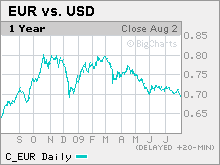Dollar edges up
Greenback sticks near 2009 low against euro after better-than-expected housing data.
NEW YORK (Reuters) -- The U.S. dollar gained modestly Tuesday, but traded near its 2009 low against the euro as a surprisingly strong U.S. housing report boosted hopes that the worst of the recession was over.
Upbeat U.S. and China manufacturing data had pushed the dollar down sharply on Monday, giving investors confidence to buy foreign currencies and riskier assets such as stocks.
But profit-taking in world stock markets on Tuesday helped the dollar rebound, though a 3.6% rise in pending U.S. home sales kept it on the defensive.
"We're taking a breather today but the market is still tilted toward higher risk appetite," said Matthew Strauss, senior currency strategist at RBC Capital Markets in Toronto.
The euro was down 0.2% at $1.4393 after trading as low as $1.4368. It hit a nine-month high of $1.4445 on Monday, according to Reuters data.
The dollar slipped 0.1% to ¥95.23 while the pound hit an eight-month high of $1.7004 before easing back to $1.6928, down about 0.1%.
The Australian dollar hit $0.8470, its highest level against the U.S. dollar since last September, after the central bank kept interest rates steady, but dropped its easing bias, boosting expectations of a rate hike this year. It was last up 0.1% at $0.8432.
The greenback rebounded from a 10-month low against the Canadian dollar to trade up 0.8% at C$1.0740.
The move accelerated after Canada's finance minister said the Canadian currency was too strong against its U.S. counterpart and added that "there are some steps that could be taken to dampen that."
Jay Meisler, principal at Global-View.com, an online forum for investors and traders, said such verbal intervention is "a wild card" traders have to watch, adding that European Central Bank officials may also face questions about euro strength when a monthly policy meeting ends on Thursday.
The Swiss National Bank has gone a step further and bought euros and dollars in the currency market to limit Swiss franc appreciation.
But analysts said investors remained bearish on the U.S. dollar and hopeful that better-than-expected second-quarter corporate results and improvement in global manufacturing activity mean the worst of the recession is over.
That has dried up demand for the dollar as a safe haven and on Monday pushed the U.S. benchmark S&P 500 index above the 1,000-point mark for the first time in nine months. European shares also hit a nine-month peak.
"Good news for the U.S. economy is bad news for the U.S. dollar," said Andrew Wilkinson, senior market analyst at Interactive Brokers in Greenwich, Conn.
For now, a forthcoming U.S. employment report and policy decisions from the ECB and Bank of England have tempered some of the animal spirits.
U.S. jobs data is due on Friday, and the median estimate of economists polled by Reuters is a 320,000 job loss in July, following June's tally of 467,000 job cuts.
"Dollar sentiment, and the dollar itself, remain fragile," said Nick Bennenbroek, head of currency strategy, at Wells Fargo Bank in New York. "U.S. employment figures likely hold the key to this week's greenback performance." ![]()


